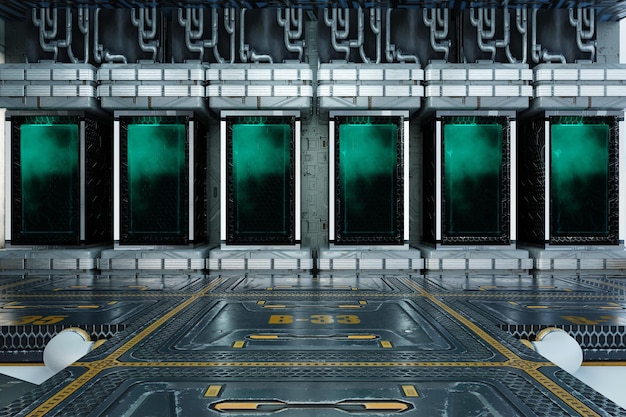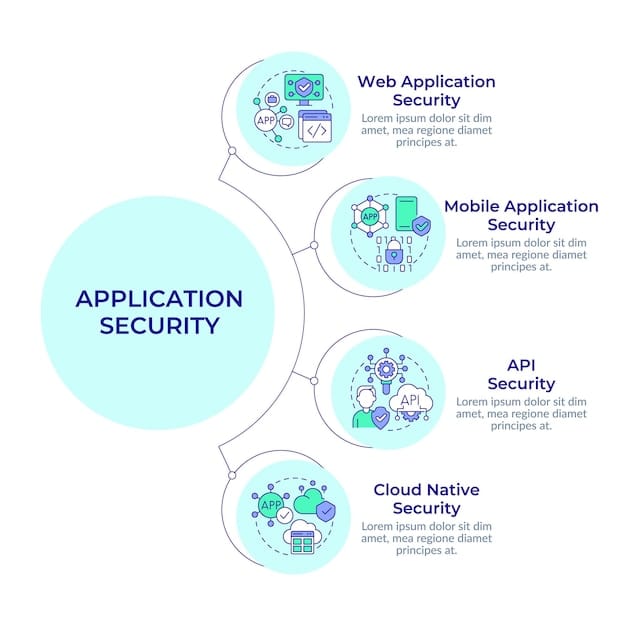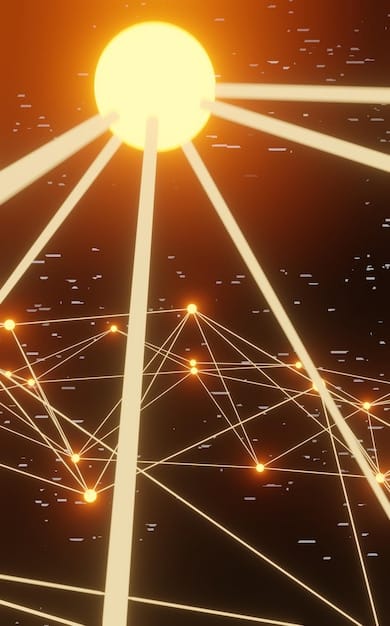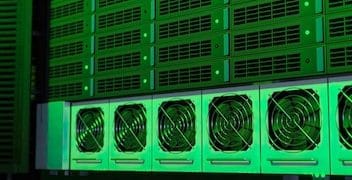How US Energy Companies Can Prepare for Rising Cyberattacks

US energy companies can prepare for the expected increase in cyberattacks by adopting robust cybersecurity frameworks, investing in advanced threat detection, enhancing employee training, and collaborating with industry partners for information sharing and coordinated response efforts.
The US energy infrastructure faces a growing threat from cyberattacks. To safeguard their operations and the nation’s energy supply, it’s crucial to understand how can energy companies prepare for the expected increase in cyberattacks targeting the US energy infrastructure? This article outlines key strategies for enhancing resilience and mitigating risks.
Understanding the Growing Cyber Threat to US Energy Infrastructure
The energy sector is becoming an increasingly attractive target for cybercriminals. The complex and interconnected nature of the US energy infrastructure makes it vulnerable to various types of cyberattacks. Recent events have highlighted the potential for significant disruption and damage.
As our reliance on digital technologies grows, so does the potential for exploitation. Understanding the nature and scope of these threats is the first step in defending against them.
The Evolving Landscape of Cyber Threats
Cyber threats are constantly evolving, with attackers developing new tactics and techniques. Energy companies must stay informed about the latest trends and adapt their defenses accordingly. This requires continuous monitoring and analysis of potential threats.
Key areas to focus on include ransomware attacks, phishing campaigns, and supply chain vulnerabilities.
Impact of Cyberattacks on Energy Companies
A successful cyberattack can have devastating consequences for energy companies. These include financial losses, reputational damage, and operational disruptions. It’s important to understand the potential impact and develop strategies to mitigate these risks.
- Financial Losses: Cyberattacks can result in significant financial losses due to ransom demands, recovery costs, and legal fees.
- Reputational Damage: A breach of security can erode trust with customers and stakeholders, leading to long-term reputational damage.
- Operational Disruptions: Cyberattacks can disrupt critical operations, leading to power outages and other service interruptions.
In conclusion, understanding the threat landscape and potential impacts is crucial for energy companies to effectively prepare for and mitigate cyber risks. Continuous vigilance and adaptation are essential in the face of evolving threats.
Implementing Robust Cybersecurity Frameworks
Establishing a strong cybersecurity framework is essential for protecting energy infrastructure. This involves implementing a set of policies, procedures, and technologies designed to prevent, detect, and respond to cyberattacks. A well-defined framework provides a foundation for security efforts.
Frameworks like the NIST Cybersecurity Framework and ISO 27001 provide valuable guidance for organizations looking to improve their cybersecurity posture.

NIST Cybersecurity Framework
The NIST Cybersecurity Framework provides a comprehensive approach to managing cybersecurity risks. It outlines five core functions: Identify, Protect, Detect, Respond, and Recover. Implementing this framework can help energy companies strengthen their defenses.
By following the guidelines and best practices outlined in the framework, organizations can improve their overall security posture and resilience.
ISO 27001 and Other Standards
ISO 27001 is an internationally recognized standard for information security management systems. It provides a framework for establishing, implementing, maintaining, and continually improving an information security management system (ISMS).
- Comprehensive Approach: ISO 27001 covers all aspects of information security, from policies and procedures to technology and physical security.
- Continuous Improvement: The standard emphasizes the importance of continually improving the ISMS to adapt to evolving threats.
- Certification: Achieving ISO 27001 certification demonstrates a commitment to information security and can enhance trust with stakeholders.
In summary, implementing robust cybersecurity frameworks such as the NIST Cybersecurity Framework and ISO 27001 is a crucial step for energy companies to protect their critical infrastructure from cyber threats. These frameworks provide a structured approach to identifying, protecting, detecting, responding to, and recovering from cyberattacks.
Investing in Advanced Threat Detection Technologies
Detecting cyber threats early is crucial for minimizing their impact. Investing in advanced threat detection technologies can help energy companies identify and respond to suspicious activity before it causes significant damage. These technologies provide real-time visibility into network traffic and system behavior.
Technologies like Security Information and Event Management (SIEM), Intrusion Detection Systems (IDS), and Artificial Intelligence (AI) play a crucial role in modern threat detection.
Security Information and Event Management (SIEM)
SIEM systems collect and analyze security logs from various sources to identify potential threats. These systems can correlate events and provide alerts to security teams, enabling them to respond quickly to incidents.
SIEM systems are essential for providing a comprehensive view of the security landscape and detecting anomalies that may indicate a cyberattack.
Intrusion Detection Systems (IDS) and Intrusion Prevention Systems (IPS)
IDS monitors network traffic and system activity for malicious activity. When suspicious behavior is detected, the IDS generates an alert. IPS takes it a step further by automatically blocking or mitigating the threat.
- Real-Time Monitoring: IDS and IPS provide real-time monitoring of network traffic and system activity.
- Anomaly Detection: These systems can detect anomalies that may indicate a cyberattack.
- Automated Response: IPS can automatically block or mitigate threats, reducing the impact of cyberattacks.
To conclude, investing in advanced threat detection technologies such as SIEM, IDS, and IPS is essential for energy companies looking to enhance their cybersecurity posture and protect their critical infrastructure. These technologies enable organizations to detect and respond to cyber threats quickly and effectively, minimizing potential damage.
Enhancing Employee Training and Awareness
Human error is a significant factor in many cyberattacks. Enhancing employee training and awareness can help reduce the risk of employees falling victim to phishing scams or other social engineering tactics. A well-trained workforce is a crucial line of defense against cyber threats.
Regular training, phishing simulations, and clear security policies are essential components of an effective employee awareness program.
Regular Security Training Programs
Regular security training programs can help employees understand the latest cyber threats and how to protect themselves and the organization. These programs should cover topics such as phishing awareness, password security, and data protection.
Training should be engaging and relevant to the employees’ roles and responsibilities.
Phishing Simulations and Testing
Phishing simulations involve sending simulated phishing emails to employees to test their ability to identify and report suspicious messages. These simulations can help identify areas where additional training is needed.
- Realistic Scenarios: Phishing simulations should mimic real-world phishing attacks to provide a realistic training experience.
- Regular Testing: Simulations should be conducted regularly to reinforce training and identify areas for improvement.
- Feedback and Education: Employees who fall victim to simulations should receive feedback and additional training to improve their awareness.
In conclusion, enhancing employee training and awareness is crucial for reducing the risk of cyberattacks. Regular training programs, phishing simulations, and clear security policies can help create a culture of security awareness within the organization, making employees an active part of the defense strategy.
Collaborating with Industry Partners and Government Agencies
Cybersecurity is not a solo endeavor. Collaborating with industry partners and government agencies can provide energy companies with valuable information and resources for defending against cyber threats. Sharing threat intelligence and best practices can enhance the overall security of the energy sector.
Organizations like the Electricity Subsector Coordinating Council (ESCC) and the Department of Homeland Security (DHS) play a crucial role in facilitating collaboration and information sharing.

Information Sharing and Analysis Centers (ISAOs)
ISAOs are organizations that facilitate the sharing of threat intelligence and best practices among industry members. By participating in an ISAO, energy companies can gain access to valuable information about emerging threats and effective mitigation strategies.
ISAOs provide a platform for collaboration and information sharing that can significantly enhance the overall security posture of the energy sector.
Public-Private Partnerships
Public-private partnerships (PPPs) involve collaboration between government agencies and private sector companies to address cybersecurity challenges. These partnerships can provide energy companies with access to government resources and expertise.
- Resource Sharing: PPPs facilitate the sharing of resources, such as threat intelligence and technical expertise.
- Policy Coordination: These partnerships can help align cybersecurity policies and regulations across the public and private sectors.
- Joint Exercises: PPPs often conduct joint exercises to test incident response capabilities and identify areas for improvement.
In summary, collaboration with industry partners and government agencies is essential for enhancing the cybersecurity of the energy sector. Information Sharing and Analysis Centers (ISAOs) and public-private partnerships (PPPs) provide valuable platforms for sharing threat intelligence, best practices, and resources, ultimately improving the resilience of the energy infrastructure.
Developing a Comprehensive Incident Response Plan
Even with the best defenses in place, cyberattacks can still occur. Having a comprehensive incident response plan is essential for minimizing the impact of a successful attack. This plan should outline the steps to be taken to detect, contain, eradicate, and recover from a cyber incident.
Regular testing and updating of the incident response plan are crucial to ensure its effectiveness.
Key Components of an Incident Response Plan
An effective incident response plan should include several key components, such as incident detection, containment, eradication, recovery, and post-incident analysis. Each of these components should be clearly defined and documented.
The plan should also include roles and responsibilities for key personnel and communication protocols for internal and external stakeholders.
Testing and Updating the Plan
It is essential to regularly test and update the incident response plan to ensure its effectiveness. This can be done through tabletop exercises, simulations, and real-world incident response scenarios.
- Tabletop Exercises: These exercises involve discussing hypothetical incident scenarios and walking through the steps outlined in the incident response plan.
- Simulations: Simulations involve simulating a real-world cyberattack and testing the organization’s ability to detect, contain, eradicate, and recover from the incident.
- Post-Incident Analysis: After any incident, a thorough post-incident analysis should be conducted to identify lessons learned and update the incident response plan accordingly.
In conclusion, developing a comprehensive incident response plan is critical for energy companies looking to minimize the impact of cyberattacks. The plan should include key components such as incident detection, containment, eradication, recovery, and post-incident analysis, and it should be regularly tested and updated to ensure its effectiveness. By having a well-defined and practiced incident response plan, organizations can quickly and effectively respond to cyber incidents, minimizing damage and downtime.
| Key Point | Brief Description |
|---|---|
| 🛡️ Cybersecurity Frameworks | Implement NIST or ISO 27001 to structure cybersecurity efforts. |
| 🚨 Threat Detection | Use SIEM, IDS/IPS for real-time monitoring and anomaly detection. |
| 👨🏫 Employee Training | Train employees on phishing awareness and security best practices. |
| 🤝 Collaboration | Share threat intelligence with industry partners and government agencies. |
FAQ
▼
Common attacks include ransomware, which encrypts critical data; phishing, using deceptive emails; and supply chain attacks, exploiting vulnerabilities in third-party vendors.
▼
Employees should receive regular, ongoing training, ideally quarterly or at least annually, to stay up-to-date on the latest threats and best practices.
▼
Government agencies provide resources, expertise, and regulatory oversight. They also facilitate information sharing and collaboration between public and private sectors.
▼
A plan should detail incident detection, containment, eradication, recovery, and post-incident analysis procedures, with clear roles, responsibilities, and communication protocols.
▼
Regular audits, penetration testing, vulnerability assessments, and tabletop exercises can evaluate the effectiveness of cybersecurity defenses and identify areas for improvement.
Conclusion
In conclusion, preparing for the expected increase in cyberattacks requires a multifaceted approach encompassing robust cybersecurity frameworks, advanced threat detection technologies, comprehensive employee training, collaboration with industry partners and government agencies, and a well-defined incident response plan. By implementing these strategies, US energy companies can significantly enhance their resilience and protect the nation’s critical energy infrastructure.





